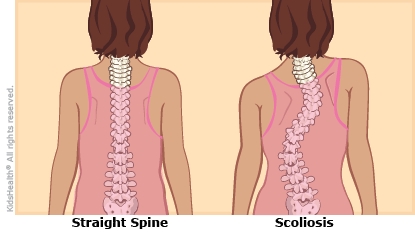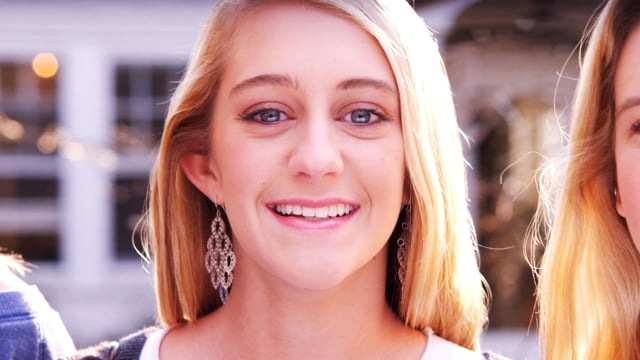- Home
- Humana Medicaid
- Kentucky Medicaid
- Medicaid extras
- Health and wellness
- Parents Home
- Para Padres
- A to Z Dictionary
- Allergy Center
- Asthma
- Cancer
- Diabetes
- Diseases & Conditions
- Doctors & Hospitals
- Emotions & Behavior
- First Aid & Safety
- Flu (Influenza)
- Food Allergies
- General Health
- Growth & Development
- Heart Health & Conditions
- Homework Help Center
- Infections
- Newborn Care
- Nutrition & Fitness
- Play & Learn
- Pregnancy Center
- Preventing Premature Birth
- Q&A
- School & Family Life
- Sports Medicine
- Teens Home
- Para Adolescentes
- Asthma
- Be Your Best Self
- Body & Skin Care
- Cancer
- Diabetes
- Diseases & Conditions
- Drugs & Alcohol
- Flu (Influenza)
- Homework Help
- Infections
- Managing Your Weight
- Medical Care 101
- Mental Health
- Nutrition & Fitness
- Q&A
- Safety & First Aid
- School, Jobs, & Friends
- Sexual Health
- Sports Medicine
- Stress & Coping
Scoliosis
What Is Scoliosis?
Scoliosis is when the vertebrae (the small bones in the spine) form a curved line instead of being straight. Sometimes they also rotate (twist), like a corkscrew. This can cause health problems.
The spine is sometimes called "the backbone," but it's not just one bone. It's made of lots of bones (called vertebrae) that are connected by a type of elastic tissue called . This gives people the flexibility to bend, stretch, balance, and even walk.
Small curves usually don't cause problems. But a curve that gets worse can be bad for a person's health. Very large curves can damage the joints and cause arthritis of the spine. Large curves can make the ribs rub against the pelvis, causing pain. If the spine curves a lot, people might get lung problems.
Health care providers treat scoliosis (pronounced: sko-lee-OH-sis) with back braces or surgery when needed.

What Are the Types of Scoliosis?
Orthopedic specialists (doctors and other health care providers who treat bone and muscle problems) group scoliosis into types. Knowing the type of scoliosis helps them know how to treat it.
- Idiopathic scoliosis. This is the most common type of scoliosis. It can happen at any age, but most cases happen around puberty during a growth spurt. Experts don't know exactly why this type of scoliosis develops (idiopathic means "from an unknown cause"), but it can run in families. It isn't caused by things like carrying a heavy backpack, bad posture, playing sports — or anything else you might do. You don't have control over whether you get scoliosis.
- Congenital scoliosis. This type of scoliosis happens when something goes wrong with the way some vertebrae developed before a baby was born. The problem might not be noticed until a child goes through a growth spurt, usually around age 2 or when they're 8–13 years old.
- Scoliosis caused by a medical condition. Some people develop scoliosis because they have a long-term medical problem that affects the muscles or skeletal system. For example, people with muscular dystrophy, cerebral palsy, Marfan syndrome, or osteogenesis imperfecta may get scoliosis. Those who have had tumors or growths on their spine may also develop scoliosis.
What Are the Signs & Symptoms of Scoliosis?
Sometimes scoliosis is easy to see. A curve in the spine can make the body tilt to the left or right. If you have scoliosis, it might look like you are leaning to one side. Some people have one shoulder higher than the other or one shoulder blade that sticks out more than the other. If your spine is twisted, one side of your ribcage might stick out more when you bend over.
Often, scoliosis isn't obvious. That's why health care providers do scoliosis exams during regular checkups. Some states have school-based scoliosis screening programs.
How Is Scoliosis Diagnosed?
If you think you have scoliosis, go to see your health care provider. They will do an exam and take your to help make a diagnosis. Part of the medical history is asking questions about your family's health because scoliosis can run in families. Finding out if relatives had it will help the doctor decide if you might too.
You may go to see an orthopedic specialist who treats diseases of the bones and muscles. They see lots of teens with scoliosis and can decide if you need treatment.
Health care providers measure scoliosis curves in degrees:
- A mild curve is less than 20 degrees.
- A moderate curve is between 25 degrees and 40 degrees.
- A severe curve is more than 50 degrees.
Severe curves can affect the lungs. Orthopedic specialists usually can work with patients to prevent curves from getting to this point.
How Is Scoliosis Treated?
Most mild scoliosis curves don't need treatment. If you have a mild curve, you'll need to go for regular checkups to be sure it doesn't get bigger. Scoliosis is more likely to get worse while a person's bones are still growing, so your doctor will monitor the curve as you grow.
Doctors will keep an eye on large curves by doing X-rays. They might decide to treat one with bracing or surgery. The treatment used depends on the type of scoliosis and how much more a person will grow.
Back Braces
If your doctor thinks your curve might get worse or cause problems, they'll probably want you to wear a back brace until you finish growing.
There are several different types of braces. Each person's curve is different, so an orthopedic specialist will figure out the number of hours you'll need to wear the brace each day and night. The brace acts as a holding device that keeps a curve from getting worse. It won't make your spine straight, but if it does its job well, your curve won't get bigger.
Your scoliosis care team will work with you to choose the right brace. This is the one that works best for the type of curve you have — but it's also the one you're most likely to wear. So make a list of questions and concerns to discuss with your care team, and let them know all the activities you like to do. Wearing a brace correctly can prevent the need for surgery.
Surgery
People with severe scoliosis might need a type of surgery called a spinal fusion. During the operation, an straightens the spine as much as possible and holds it in place with rods and screws. The surgeon then puts in a to join (fuse) some of the vertebrae together. That way, the curve can't get any worse.
After about a year, the bones should be fully fused. The metal rods are no longer needed, but they stay in the back because they aren't doing any harm and taking them out requires another operation.
What Else Should I Know?
There's no quick fix for scoliosis. Wearing a brace or recovering from surgery takes a while. For some people, this can be tough. If you'd like, your care team can put you in touch with other people who have gone through the same thing or help you find support groups.
When treatment is over, people with scoliosis can live full and active lives. With the right treatment, your spine usually won't continue to curve after you're done growing.

Understanding Scoliosis
Find out more about what scoliosis is, who gets it, and what to expect during treatment.

© 1995- The Nemours Foundation. KidsHealth® is a registered trademark of The Nemours Foundation. All rights reserved.
Images sourced by The Nemours Foundation and Getty Images.